If you’ve ever felt like your dog knows exactly what you’re thinking, you might be right.
This is according to a new study that has revealed that dogs’ brains synchronize with ours when they look us in the eyes.
Scientists at the Chinese Academy of Sciences found that neurons in parts of the brain associated with attention synchronized more strongly as dog-human pairs became more familiar.
However, dogs with a gene that causes autism-like symptoms showed much less synchronization.
It has long been known that human brains synchronize when we interact, but this is the first time that brain synchrony has been observed across species.
Researchers have discovered that the brains of humans and dogs synchronize when they look into each other’s eyes (file image)
Whenever humans interact in social situations, the activity patterns in our brains and bodies begin to fall into synchronized patterns.
Subconsciously, our heart rate, breathing, and the firing of neurons in the brain become the same as those of the people around us.
In their paper, published in Advanced Science, the researchers explain: “During social interactions, interacting individuals are not isolated, but rather are integrated into a multi-brain system.”
Scientists have recently observed that mice, bats and monkeys also experience a similar type of synchronization when interacting with members of their own species.
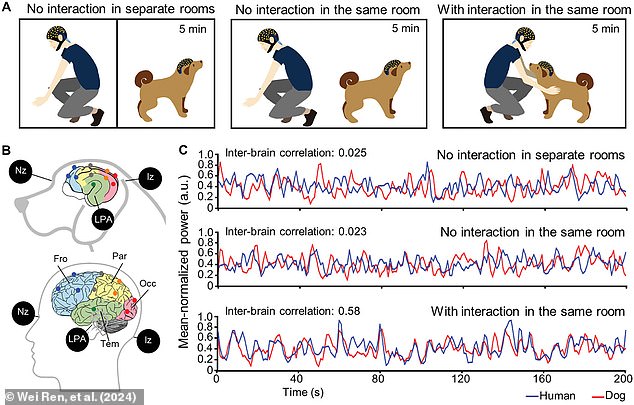
Scientists monitored the brains of humans and dogs while they were separated, in the same room, or interacting. As these graphs show, levels of synchronization were much greater while the pair were interacting (bottom graph).
But until now, scientists had never observed brain synchronization between members of two different species.
To try to understand whether this was possible, the researchers placed EEG monitors on pairs of humans and dogs to record their brain activity levels.
Dogs were chosen as the experimental animal of choice because research has shown that dogs have a remarkably deep connection with humans.
The brain activity of previously unknown couples was recorded while they were in separate rooms, in the same room but not interacting, and while they caressed each other and looked into each other’s eyes.
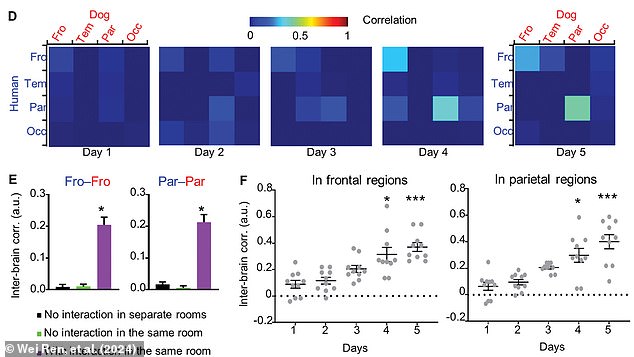
Over the course of five days, the level of synchronization increased (illustrated in the graphs below). In the top graph, the brighter colors show the brain regions that were more synchronized as the pair became more familiar.
Researchers found that couples’ brains synchronized much more while interacting than when they were in the same room.
The researchers write: “We have shown for the first time that directed interbrain neural coupling occurs between humans and dogs, especially in the frontal and parietal regions, both associated with joint attention.”
The level of synchronization also increased dramatically over five days of testing as the pairs became more familiar with each other.
In a second experiment, participants were asked to pet the dog without making eye contact or simply make eye contact without touching it.
Both forms of interaction increased the level of brain synchronization, but eye contact was associated with increased activity in the frontal region of the brain, while caressing produced activation in the parietal region.
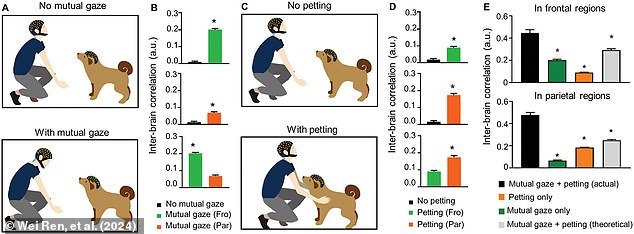
In a second experiment, humans either looked at or petted the dog. This revealed that physical petting and staring cause different parts of the brain to synchronize.
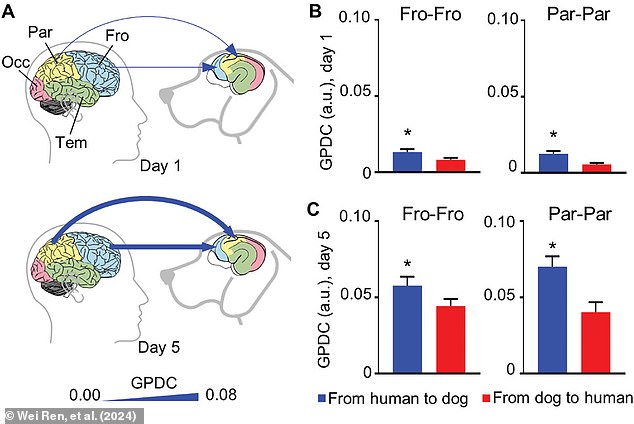
When analyzing the data, the researchers found that it was the humans who were leading the interaction. These graphs show the amount of data that was “flowing” from the human to the dog (in blue) compared to the amount of data that was flowing from the dog to the human (in red).
Importantly, the synchronization created by joint touch and gaze was greater than the sum of these interactions separately.
This suggests that interactions that use more than one form of communication create a much stronger connection at the neural level.
The researchers also used these findings to deepen our understanding of autism spectrum disorders (ASD).
Using the gene editing technique CRISPR, researchers created dogs with a mutation in the SHANK3 gene, one of the most common risk factors for ASD.
Dogs with this mutation displayed clearly autism-like behaviors and showed significantly reduced brain synchrony when interacting with humans.

Researchers found that dogs with autism-like symptoms did not show brain synchronization, a condition that could be cured with a single dose of LSD (file image)
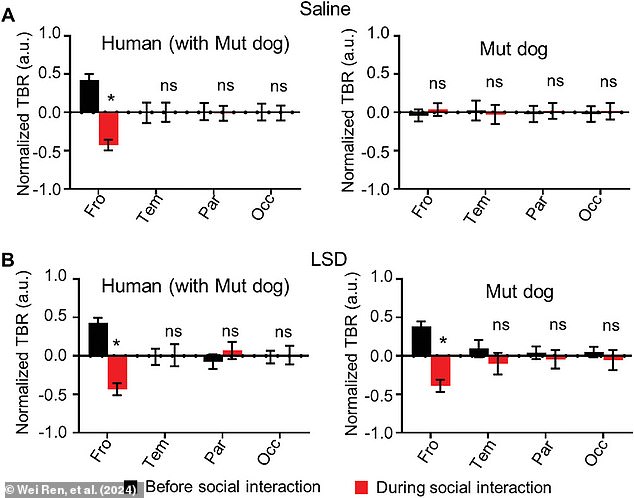
Dogs with a genetic mutation linked to autism showed much lower levels of brain synchrony. However, 24 hours after receiving a dose of LSD their levels of neuronal connection returned to normal.
Co-author Dr Yong Zhang from the Chinese Academy of Sciences said: “Disrupted interbrain synchronization could be used as a biomarker for autism.”
However, in an unusual development, the researchers also discovered that a single dose of the psychedelic LSD was able to almost completely reverse these effects.
The dogs were given a dose of 7.5 micrograms of LSD per kilogram of body weight, the equivalent of a dose of 600 micrograms for an 80 kg human.
For reference, a 2021 study They found that a dose of 200 micrograms in humans was enough to produce “ego dissolution” and “boundless oceania.”
Twenty-four hours after administering the drug, the researchers ran the test again and found that synchronization increased significantly in the parietal and frontal regions.
Researchers say these findings could pave the way for treating or controlling some of the disruptive symptoms of autism spectrum disorders in humans.
Dr. Zhang says: ‘LSD or its derivatives may improve the social symptoms of autism.’

